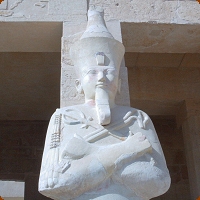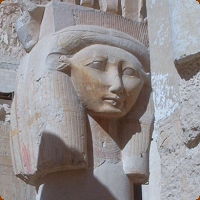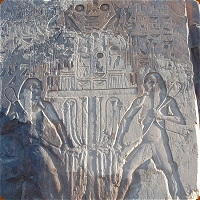
Avalonia
My Eclectic Study Forum
|
| | | Temples and Tombs |  |
| | | Author | Message |
|---|
Trinity
Admin

Posts : 1150
Join date : 2016-06-07
 |  Subject: Temples and Tombs Subject: Temples and Tombs  Sat Sep 17, 2016 2:35 pm Sat Sep 17, 2016 2:35 pm | |
| Temples,Tombs and Monuments The Temples, Tombs and Monuments of Ancient Egypt and Archaeological sites from Aswan to Cairo. This thread will cover some of the lesser known and visted sites, as well as the more well known, such as the Valley of the Kings, Abu Simbel and the Temple of Hatshepsut.
Last edited by Trinity on Sat Sep 17, 2016 3:21 pm; edited 2 times in total | |
|   | | Trinity
Admin

Posts : 1150
Join date : 2016-06-07
 |  Subject: Re: Temples and Tombs Subject: Re: Temples and Tombs  Sat Sep 17, 2016 2:36 pm Sat Sep 17, 2016 2:36 pm | |
| Temple of Hatshepsut Location: Luxor, Valley of the Kings Site: Mortuary Temple of Hatshepsut, daughter of Tuthmosis I and wife of Tuthmosis II Period: 18th Dynasty, 1486-68 BC
Only a few women ruled ancient Egypt as Pharaohs, and among them the most important was Queen Hatshepsut of the `New Kingdom,' which had such great pharaohs as Amenhotep, Thutmose and Tutankhamun. Her rule (1473-1458 B.C.) saw the construction of magnificent temples dedicated to ancient Egyptian gods and goddesses.  The dynasty was noted for its magnificent temples at Karnak, Luxor and, later, at Abu Simbel. Queen Hatshepsut carried on the tradition of temple constructions and embellished them with immense contributions.
Deir el BahriThe name in Arabic is Deir el Bahri, meaning "Monastery of the North" and called by the ancient Egyptians Djeseru-Djeseru, "Holy of Holies" or "sacred of sacreds". Hatshepsut’s terraced and rock-cut temple is one of the most impressive monuments of the west bank. The queen's architect, Senenmut, designed it and set it at the head of a valley overshadowed by the Peak of the Thebes, the "Lover of Silence," where lived the goddess who presided over the necropolis.  The terraced design of her temple copies and elaborates upon the design of the earlier temple to the left, belonging to Mentuhotep Nebhepetra, who founded the Middle Kingdom (c. 2060-1785 B.C.). The approach to the temple was along a 121-foot wide, causeway, sphinx-lined, that led from the valley to the pylons. This avenue was once tree-lined and the remains of the fossilised incense tree stumps, brought back from Punt, can still be seen. The axial plan provided symmetry. It consisted of three broad courts separated by colonnades. These terraces were linked by ascending ramps, and bounded by dressed limestone walls.  At the southern end of the second colonnade is a chapel to Hathor chapel. The chapel contains a vestibule with the characteristic Hathor-headed pillars, a 12-columned hypostyle hall and inner rooms also decorated with various scenes of Hatshepsut and Hathor. At the northern end of the same colonnade is a somewhat smaller chapel of Anubis, again with a 12-columned hall and inner rooms. The sanctuary and shrine were cut deep into the red sandstone cliff like the rock-cut tombs of the Middle Kingdom. The sanctuary on the highest level of the complex contained a solar cult chapel and a shrine for the royal cult. | |
|   | | Trinity
Admin

Posts : 1150
Join date : 2016-06-07
 |  Subject: Re: Temples and Tombs Subject: Re: Temples and Tombs  Sat Sep 17, 2016 2:40 pm Sat Sep 17, 2016 2:40 pm | |
| Colossi of Memnon Location: Colossi of Memnon
Site: Luxor, Valley of the Kings
Period: 18th Dynasty These huge statues (19.5m), are the only part of the ancient mortuary temple built in Thebes by Amenhotep III (18th dyn) that remains today. Several floods have wiped out the other ruins of this temple. Ancient Egyptians called the southern of the two statues "Ruler of Rulers". The statues are made from carved blocks of quartzite quarried either at Giza or Gebel es-Silsileh. The Northern statue depicts Amenhotep III with his mother, Mutemwia, while the southern statue is of Amenhotep III with his wife, Tiy and one of his daughters.  These statues where called the Colossi of Memnon in Greek times, when they decided that the colossi represented their hero, memnon. He was a king of Ethiopia son of the dawn god Eos, who died in hands of Achilles. After an earthquake in 30 bc, one of the statues produced a musical sound under certain weather conditions. To be granted a song meant that you were very much in favour of the gods. Visitors came from miles around to hear the music, including Emperor Hadrian, in 130 A.D. Egyptians thought this sound came from the gods, and Greeks thought it was Memnon's voice. Unfortunately a Roman emperor Septimius Severus, repaired the statues in 199 AD, and since then the sound has never been heard again. | |
|   | | Trinity
Admin

Posts : 1150
Join date : 2016-06-07
 |  Subject: Re: Temples and Tombs Subject: Re: Temples and Tombs  Sat Sep 17, 2016 2:42 pm Sat Sep 17, 2016 2:42 pm | |
| The Dakhleh Oasis Project
The Dakhleh Oasis Project is a long-term regional study of the interaction between environmental changes and human activity in the closed area of the Dakhleh Oasis, Western Desert of Egypt. The study includes all the time since the first incursion of humans in the Middle Pleistocene, perhaps 400,000 years ago, down to the 21st century oasis farmers, and all the human activity and all the changing environmental conditions for which there is evidence within the time period. The Dakhleh Oasis Project has been conducting this wide study since 1978, supported by a number of universities and organizations. Among these have been Monash University, The University of Durham, the University of Toronto, Columbia University, New York University, The Royal Ontario Museum, the Society for the Study of Egyptian Antiquities, the American Research Centre in Egypt, the Egyptology Society of Victoria, as well as the many institutions of the various participating scholars which support individuals. Anthony J. Mills is the Director of the Dakhleh Oasis Project. The Dakhleh Oasis lies some 600 km SSE of Cairo, surrounded by the wastes of the eastern Sahara. The oasis is some 80 km west-east and 25 km north-south. The local economy is based in agriculture, and there are no known mineral or other viable resources. The capital is at Mut, which has been the main town since at least the eighteenth dynasty, about 1,500 BCE. Before then, the site of 'Ain Asil at Balat in eastern Dakhleh had been the seat of the government, since 2,500 BCE , and before that the less settled Neolithic and earlier populations inhabited the area. The Dakhleh Oasis has had a continuity of settlement for about the last 8,000 years but only since 2,500 BCE has it been politically tied to the Nile region. Climatic trends and events that can be discerned in most of the eastern Sahara are also seen at Dakhleh. The first European traveller to 'discover' the Dakhleh Oasis was Sir Archibald Edmonstone, in 1819. He was followed by several other early travellers, but it was not until 1908 that the first egyptologist, Herbert Winlock, visited the oasis and noted its monuments in a systematic manner. Only in the 1950s was any real interest taken, first by Dr. Ahmed Fakhry, and in the late 1970s an expedition of the Institut Français d'Archéologie Orientale and the Dakhleh Oasis Project each began detailed studies in the oasis. | |
|   | | Trinity
Admin

Posts : 1150
Join date : 2016-06-07
 |  Subject: Re: Temples and Tombs Subject: Re: Temples and Tombs  Sat Sep 17, 2016 3:25 pm Sat Sep 17, 2016 3:25 pm | |
| Cleopatra's Needle Location: Thames embankment, London
Site: Heliopolis (City of the Sun)
Period: 18th Dynasty Carved from a single block of red granite which was said to have been quarried at Aswan, the obelisk is 68ft 5½ inches in height (20.87m) and weighs 186 tons. Thought to have been created as a habitation for one of the spirits of the Sun God, for many centuries it had resided in Alexandria but was given to the British in 1819, in gratitude for the British victory over the French Fleet in the Battle of the Nile in 1798 and transported to London in 1877-78 by Sir Erasmus Wilson and now stands on the Thames embankment. The needle was first erected in Heliopolis (City of the Sun) by order of the pharaoh Thuthmosis III during the 18th Dynasty4, it was moved to Alexandria (the royal city of Cleopatra) during the last century BC. At the time Heliopolis was considered the Oxford of ancient Egypt, students were brought to read and create hieroglyphs by studying the four sides of the obelisk. The companion obelisk stands in New York Central Park and was presented as a gift to America in 1883 by the Rhedive of Egypt. The obelisk is carved with hieroglyphs praising Thuthmosis and commemorating his third Sed festival. Later inscriptions were added by Ramesses II to commemorate his victories. Around the base of the obelisk are four plaques giving a brief history of the needle. The obelisk quarried at Syene Was brought to On (Heliopolis) By the Pharoah Thuthmosis III in about 1500BCLateral inscriptions were added nearly two centuries later By Ramesses the Great Removed during the Greek Dynasty to Alexandria, The Royal city of Cleopatra. It was erected in the 18th year of Augustus Caesar BC12 Notes1. Rose red granite of Syene. 2. Mahommed Ali, Viceroy of India in memory of Nelson and Abercromby. 3. Encased in a iron cylinder, it was abandoned during a storm in the Bay of Biscay. Recovered and erected by John Dixon CE in the 42nd year of the reign of Victoria, 1879. 4. 1500BC | |
|   | | Sponsored content
 |  Subject: Re: Temples and Tombs Subject: Re: Temples and Tombs  | |
| |
|   | | | | Temples and Tombs |  |
|
| | Permissions in this forum: | You cannot reply to topics in this forum
| |
| |
| |
|

